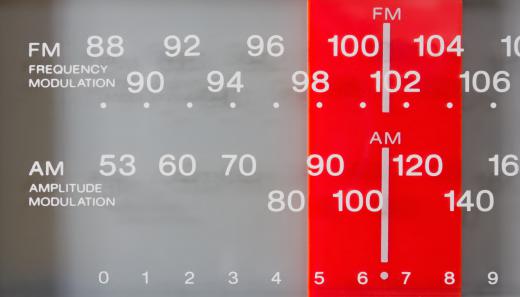A tuned amplifier is a type of electronic device designed to amplify specific ranges of electrical signals while ignoring or blocking others. It finds common use in devices that work with radio frequency signals such as radios, televisions, and other types of communication equipment; however, it also can be useful in many other applications. Tuned amplifiers can be found in aircraft autopilot systems, audio systems, scientific instruments, spacecraft, or anywhere else when there is a need to select and amplify specific electronic signals while ignoring others.
The most common tuned amplifiers an average person interacts with can be found in home or portable entertainment equipment, such as FM stereo receivers. An FM radio has a tuned amplifier that allows listening to only one radio station at a time. When the knob is turned to change the station, it adjusts a variable capacitor, inductor, or similar device inside the radio, which alters the inductive load of the tuned amplifier circuit. This retunes the amplifier to allow a different specific radio frequency to be amplified so a different radio station can be heard.

All radio-based communication devices, including stereos, televisions, and cell phones, simultaneously receive all signals present in a given area. The tuned amplifier within the device is what allows only one specific frequency to be amplified, through a process called bandpass filtering. In bandpass filtering, the electronics are configured in such a way that they only allow a specific band of frequencies to pass through the filter. In some devices, such as FM radios, the filter is adjustable. In others, such as cell phones or computer WiFi networks, the filter is fixed to a single specific frequency range.

Fixed frequency tuned amplifiers can also be found in audio processing equipment such as graphic equalizers. For example, in a five-band graphic equalizer, there are five separate controls. Each of these controls manipulates an individual tuned amplifier. In this case, each of the bandpass filters in the tuned amplifiers is fixed, allowing a distinct range of sound frequencies to pass through each of the controls. Adjusting the control for one of these bands of sound frequency adjusts the amount of amplification for the band, not the actual frequency range of the band itself.

Tuned amplifiers can have adjustable bandpass filters, adjustable amplifiers, both, or neither. The function that identifies a tuned amplifier is that the signals amplified are limited, or tuned, to a specific range or band of frequencies. The ability to be configured in so many variations for so many different purposes has made the tuned amplifier a mainstay in almost all sophisticated electronic devices that exist.
